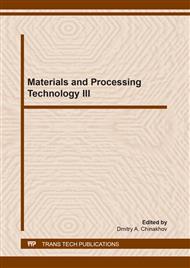[1]
T. Turpin, J. Dulcy, M. Gantois, Carbon diffusion and phase transformations during gas carburizing of high alloyed stainless steels: experimental study and theoretical modeling, Metallurgical and Materials Transactions A. 36 (2005) 2751-2759.
DOI: 10.1007/s11661-005-0271-4
Google Scholar
[2]
E.L. Gilukyanov, V.V. Kislenkov, S.P. Provotorov, Calculations of carbon concentration profile at steel cementation in controlled atmosphere of natural gas, Metallurgical and Metal heat treating. 8 (1981) 9-11.
Google Scholar
[3]
C.A. Stickels, Analytical models for the gas carburizing process, Metallurgical and Materials Transactions B. 20 (1989) 535-546.
DOI: 10.1007/bf02654603
Google Scholar
[4]
A.A. Smirnov, Theory of alloys introduction, Science, Moscow, (1979).
Google Scholar
[5]
A.A. Smirnov, Theory of diffusion in alloys introduction, Science Dumka, Kiev, (1982).
Google Scholar
[6]
R. Trivedi, Effect of Concentration-dependent Diffusion Coefficient on the Migration of Interphase Boundaries, J. Appl. Phys. 38 (1967) 3569-3576.
DOI: 10.1063/1.1710174
Google Scholar
[7]
P. Thibaux, Carbon Diffusion Measurement in Austenite in the Temperature Range 500 °C to 900 °C, Metal. Mater. Trans. A. 38 (2007) 1169-1176.
DOI: 10.1007/s11661-007-9150-5
Google Scholar
[8]
S.-J. Lee, Carbon Diffusivity in Multi-component Austenite, Scr. Mater. 64 (2011) 805-808.
Google Scholar
[9]
M.E. Blanter, Diffusion of carbon in austenite, MTF. 17 (1947) 1331-1339.
Google Scholar
[10]
C. Wells, Diffusion Coefficient of Carbon in Austenite, Trans. Met. Soc. AIME. 188 (1950) 553-560.
Google Scholar
[11]
R.P. Smith, The Diffusivity of Carbon in Iron by the Steady-state Method, Acta Metall. 1 (1953) 578-587.
Google Scholar
[12]
P.L. Gruzin, Application of carbon isotope C14 for the study of carbon diffusion in steel, DAS USSR. 100 (1955) 1069-1072.
Google Scholar
[13]
D.C. Parris, The Diffusivity of Carbon in Austenite, Acta Metall. 34 (1975) 523-528.
Google Scholar
[14]
R.A. Collin, Mathematical Model for Predicting Carbon Concentration Profiles of Gas-carburized Steel, J. Iron and Steel Inst. 10 (1972) 785-789.
Google Scholar
[15]
J.I. Goldstein, Diffusion Modeling of the Carburization, Metall. Trans. A. 9A (1978) 1515-1525.
Google Scholar
[16]
G.G. Tibbetts, Diffusivity of Carbon in Iron and Steels at High Temperatures, J. Appl. Phys. 9 (1980) 4813-4816.
Google Scholar
[17]
R.H. Siller, The Variation with Composition of the Diffusivity of Carbon in Austenite, Trans. Met. Soc. AIME. 245 (1969) 697-700.
Google Scholar
[18]
R.H. Siller, The Application of the First Order Mixing Statistics to the Variation of the Diffusivity of Carbon in Austenite, Metall. Trans. 1 (1970) 985-988.
DOI: 10.1007/bf02811782
Google Scholar
[19]
R.B. McLellan, The Diffusion of Carbon in Austenite, Acta metal. 3 (1988) 531-537.
Google Scholar
[20]
H.K.D.H. Bhadeshia, Diffusion of Carbon in Austenite, J. Metal Sci. 15 (1981) 477-479.
Google Scholar
[21]
J. Agren, Computer Simulation of the Austenite / Ferrite Diffusional Transformations in Low Alloyed Steels, Acta Metall. 30 (1982) 841-851.
DOI: 10.1016/0001-6160(82)90082-7
Google Scholar
[22]
J.A. Agren, Revised Expression for the Diffusivity of Carbon in Binary Fe-C Austenite, Scr. Metall. 20 (1986) 1507-1510.
DOI: 10.1016/0036-9748(86)90384-4
Google Scholar
[23]
Lucia Panizzi, On a mathematical model for case hardening of steel, Berlin, (2010).
Google Scholar
[24]
A.N. Venediktov, V.E. Ovsyannikov, N.L. Venediktov, Determination of the effective diffusion coeffi cient of vacancies in ultradispersed electrolytic iron and its effect on heat treatment conditions, Metal Working and Material Science, 2019, vol. 21, no. 3, pp.106-114.
DOI: 10.17212/1994-6309-2019-21.3-106-114
Google Scholar


